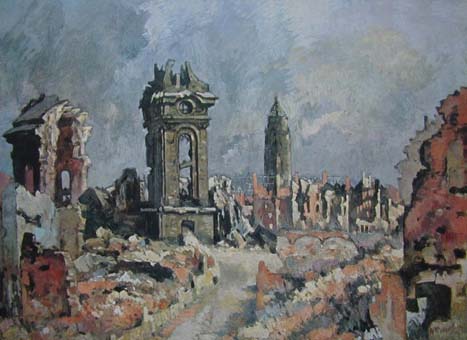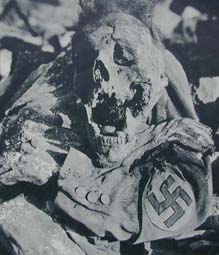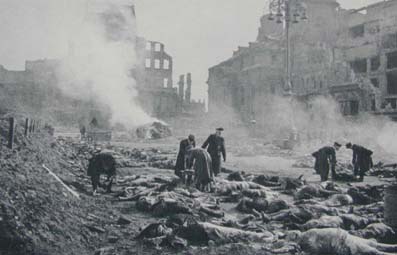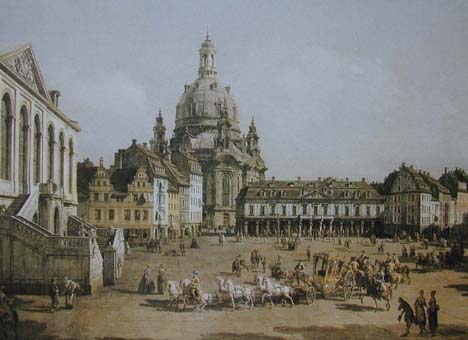

The Destruction of DresdenMemories by Klaus-Eckard Riesstranslated by Laila Trevor When I was 6 years old I experienced the destruction of Dresden by British and American bombs. Despite we lived in a house about 8 kilometers apart from the center of the town, that night of horror the 13th February 1945 has left an indelible mark on my memory. Throughout my childhood I recall the center of the city as an endless desert of ruins where therefore us was no reason to go apart from crossing it on bicycle by tram or on foot. Until when I was about 20 and developed a certain knowledge of the political and military historical connections to the WWII, I had very little idea that Dresdens fall was the last horrendous answer to the bombings of Rotterdam, London, Coventry and other cities.  Dresden in ruins by Karl Kroener It was the droning and continous noice of engines which on the eve of Shroves Tuesday made my father leave the house. He saw the sky lit by flares, so-called X-mas trees, and he dashed back indoors only to find my mother in shock over the radio message that a stream of bombers were on their way towards Dresden. The alarm must have failed, the sirens wailing was accompagnied by the first bombs exploding. We children were pulled from the beds and dressed in the cellar. Meanwhile the house was shaking, the windows rattling and the lights went out under the rhytm of the blanket bombing with their rumbling volleys. The poor people the poor people my mother repeated with a shaking voice. The next half or whole hour seemed endless before we risked leave the cellar to go outside. Opressed by the sight of the purple sky above the burning city, we stood together with the neighbours at the gardengate, while explosions could be heard in the distance and the sound of the firebrigade´s sirens, as they drove towards the sea of flames and a certain dead. Once again in bed I remember lying listening to the distant explosions. Time-bombs I was told. My mothers sinister premonition came true. One o´clock in the morning, a new even more voilent attack drove us underground once again. In the morning we had to be evacuated because of a suspected time bomb nearby. By midday the bombs were again falling like hail. This time surburbia also suffered. From there streams of people escaped in haste in order to look for refuge with relatives or friends in the countryside. For days fat black clouds of smoke blew past us and it rained soot and burnt bits of paper. The first news of horror reached us, my aunt Lotte had lost both her legs. News of who had escaped the fire of hell, news of who had lost everything. News of the many friends who had gone missing and about the heaps of small chared bodies. My younger brother´s godmother dug out from under her collapsed house by soldiers was thrown on a heap of dead bodies. There she slowly regained consciousness. Remaining speachless for months because of the shock and the poisonous fumes she recovered and started to live a normal life. Our aunt Kaethe only managed to save the clothes she was in, as she escaped from her burning house in the inner city, but she never lost her indomitable zest for life. During the following nights bombings she entertained the children in the cellar such exiting stories that they refused to leave the shelter when the sirens called off the alarm. That was before psychological shock treatment was discovered. Our parents tried to protect us from all the horrors, but I recall the mountains of bricks, the emty sooty windows, the lonely chimneys, the destroyed houses and churches and the endless landscape of ruins.
 A tram stop It is assumed that Winston Churchill at the Yalta conference promised Stalin an event which could accelerate the German retreat and demoralize the populations. Many had hoped that Dresden would by spared. The city was overpopulated with refugees, there was hardly an air defence and no concrete shelters. Nor had the Nazi propaganda informed the population of the horrendous experiences of other bombed out cities. Therefore the result of this bombardment was dreadful, even though Air-Marshal Harris had not by far utilized all the material at his disposal. Maurice Smith the master bomber in his Mosquito led the attack after the city had been marked with radar markers and lit by flares. From 8000 meters the aeroplanes co-ordinating the attack flew in circles providing the contact between the bombers and even with the HQ in England. In vertical dives targetfinders dropped red and green flares on Friedrichstaedter Stadion, which was the bull´s eye and the center of the fanshaped bomb blanket, which was spread by 244 Lancasters from 4000 meters. The deep drone of many aircraft engines and the violent rhytmic rumble of the explosions still remain in my ear. Neither the train stations nor the bridges over the River Elbe or the factories were within the precisely marked death zone. The people who did not manage to escape before the city center was transformed into a huge furnace, were burned alive or succumbed in the boiling asphalt, were crushed under collapsing houses or suffoced by CO2 in the cellars, or by the inferno which whirled them into a sea of flames. Three hours later yet another wave of attacks hit the already death marked city. 529 Lancasters emptied their murderous load of predominantly heavy incendiary bombs over the areas which innitially had escaped. The main train station where overfilled trains for refugies had been parked was changed into a mass grave. However it was no more damaged than General Hampe´s special units had the first trains running again in three days. Phosforous bombs and mines covered the park greens in Grosser Garten and caused yet another inferno for the thousands of people who had just escaped the death in the flames.  The face of death The survivers sufferings had not ended. Midday the following day 400 flying fortresses without mercy hammered the fleeing hordes. While we still were sitting perplexed hiding in the school´s shelter, my father, who two years earlier had lost a leg in an accident and therefore could not be at the front, biked to his office in the Zeiss Ikon factory. Everything there was in flames. The building where his office had stood was totally levelled to the ground. When the inforno stilled the town´s cindered stone desert was covered with dead bodies. The following days carts drove to the mass graves at the Heidefriedhof. But the burrials could not be carried out fast enough. As the threat of epidemics was serious 7000 bodies were heaped up on Altmarkt doused with petrol and burned. Thousands of victims were never found and many not until the cellars were opened at a much later date.  7000 dead bodies were burned on the Altmarkt The exact death toll was impossible to estimate. The propaganda suggested 250.000 dead. Others insisted the number was 100.000. While the impression today is that the number is nearer 35.000 dead. Dresden and its inhabitants will to live was not totally crushed. After the Nazi regime´s collapse the tidying up and the reconstruction began. At first at a slow pace, then with increasingly greater speed. Even though the main clearing happened during the DDR period, I always maintain that Dresden was destroyed three times:
 The Frauenkirche is destroyed and MartinLuther is lying on the ground Today 60 years after the destruction of Dresden and 15 years after the fall of the Berlin Wall, Dresden once again has become a very attractive city and not least because of the beautiful surroundings. The renovation, the modernisation and the cultural life blooms as never before. Frauenkirche has been rebuilt stone by stone as a symbol for the city´s resurrection, for the reunification of Germany and for freedom. The Frauenkirche was re-consecrated in its old shape at Dresden´s 800 years jubilee in 2006.  The cupola of the Frauenkirche does again decorate the picture of Dresden E-mail: klauseckardriess583@gmail.com Til start af siden |